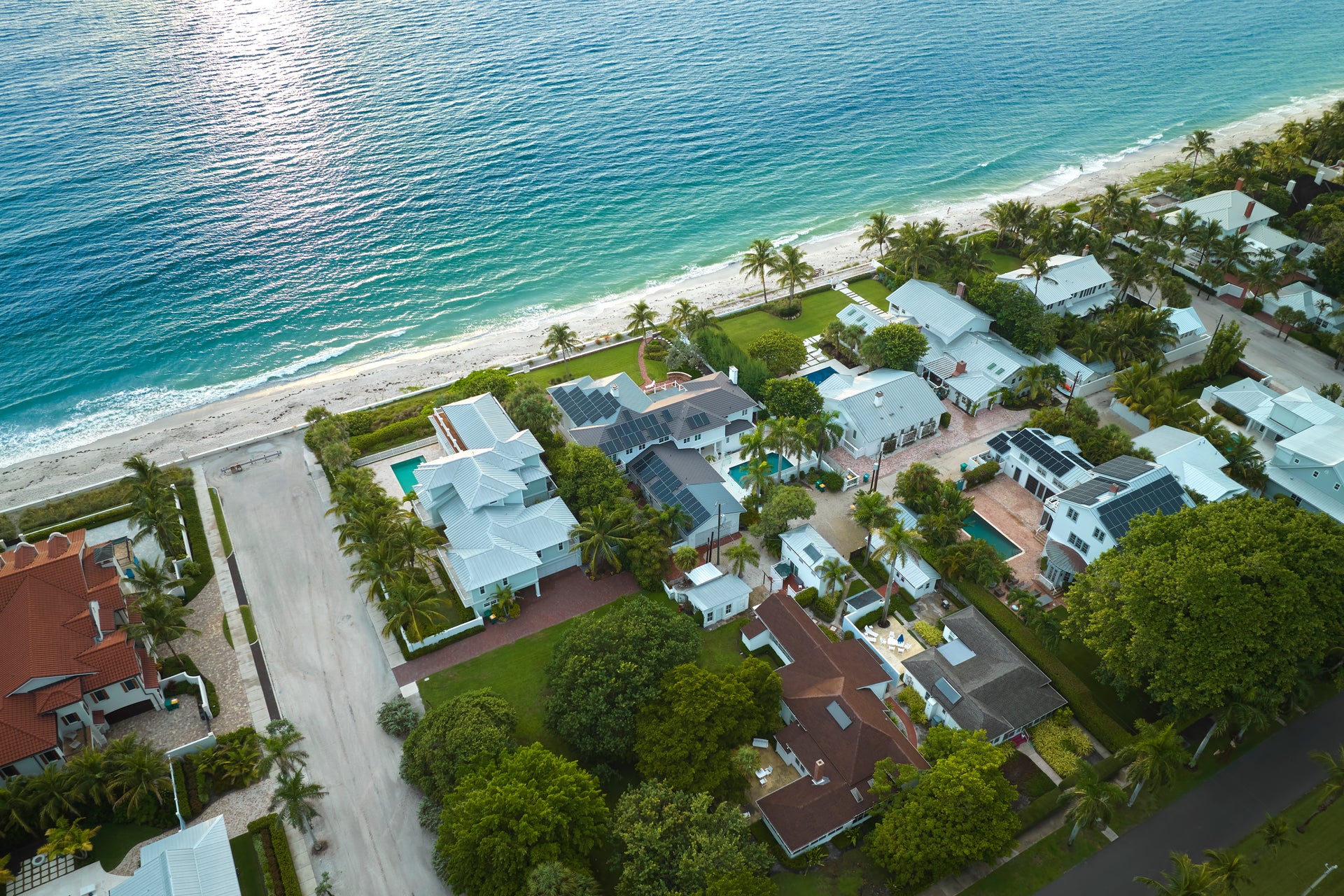Data Through Q3 2024
The CoreLogic Homeowner Equity Insights report is published quarterly with coverage at the national, state, and metro level and includes negative equity share and average equity gains. The report features an interactive view of the data using digital maps to examine CoreLogic homeowner equity analysis through the third quarter of 2024.
Negative equity, often referred to as being “underwater” or “upside down,” applies to borrowers who owe more on their mortgages than their homes are worth. Negative equity can occur because of a decline in home value, an increase in mortgage debt, or both.
This data only includes properties with a mortgage. Non-mortgaged properties (that are owned outright) are not included.
Homeowner Equity Q3 2024

CoreLogic analysis shows U.S. homeowners with mortgages (roughly 62% of all properties*) have seen their equity increase by a total of $425 billion since the third quarter of 2023, a gain of 2.5% year over year, bringing the total net homeowner equity to over $17.5 trillion in the third quarter of 2024.
*Homeownership mortgage source: 2022 American Community Survey.
In the third quarter of 2024, the total number of mortgaged residential properties with negative equity increased by 3.5% from the second quarter of 2024, to currently about 990,000 homes with negative equity, or 1.8% of all mortgaged properties. On a year-over-year basis, negative equity declined by 3%, or about 30,000 fewer homes in negative equity from the third quarter of 2023.
Because home equity is affected by home price changes, borrowers with equity positions near (+/- 5%) the negative equity cutoff are most likely to move out of or into negative equity as prices change, respectively. Looking at the third quarter of 2024 book of mortgages, if home prices rose by 5%, 113,000 homes would regain equity; if home prices fell by 5% 155,000 would fall underwater. The CoreLogic HPI Forecast TM projects that home prices will increase by 2.3% from September 2024 to September 2025.

Equity Gains Head Up in the Northeast, Western States See Declines
For the first time since the fourth quarter of 2022, the share of negative equity rose in the U.S. on a quarterly basis. Just compared to last quarter, the number of residential properties that fell into negative equity increased by 30,000 homes or 1.8%.
While almost 1 million residential homeowners are now contending with negative equity on their homes, many other homeowners are benefitting from the continued rise in home prices and the resulting boost in equity.
While average equity gains were $5,700 between Q3 2023 and Q3 2024, this is far less than the jump seen last quarter when annual equity gains hit $25,400.
States in the Northeast, where equity gains are strongest, also saw the most home price growth. Prices in New Jersey and Rhode Island reached new highs in October, with these states claiming the top two spots for year-over-year price gains, rising 8.1% and 7.5%, respectively. In tandem with the home price gains, homeowners saw the largest equity gains in these northeastern states.
Meanwhile, Hawaii, Colorado, and Idaho, which were former work-from-home hotspots that attracted people with their picturesque landscapes, saw home equity drop this quarter. Hawaii saw the most significant dip in home equity with an average loss of $34,000.
National Aggregate Value of Negative Equity: Q3 2024
The national aggregate value of negative equity was approximately $324 billion at the end of the third quarter of 2024. This is up quarter over quarter by approximately $4.3 billion, or 1%, from $319 billion in the second quarter of 2024 and up year over year by approximately $9.1 billion, or 3%, from $315 billion in the third quarter of 2023.
Negative equity peaked at 26% of mortgaged residential properties in the fourth quarter of 2009, based on the CoreLogic equity data analysis which began in the third quarter of 2009.

“As home prices flattened in the third quarter, home equity gains also slowed, even declining in some regions of the country. While home equity closely depends on home price changes, equity losses are also tied to natural disaster events since households can lose a lot of their equity following a catastrophe, particularly if not property insured. As a result, following Maui’s 2023 devastating wildfire, Hawaii now tops the list with largest decline in home equity.
Nevertheless, Hawaiian homeowners still rank high for homeowner equity, with equity averaging $700,000. Nationally, average homeowner equity remains near a historical peak at over $311,000. Still, recent devastating weather events underscore the importance of maintaining that equity, particularly for households for which this is the only source of wealth.”
-Dr. Selma Hepp
Chief Economist for CoreLogic
National Homeowner Equity
For the third quarter of 2024, the average U.S. homeowner gained approximately $5,700 in equity during the past year.
Rhode Island ($43K), New Jersey ($43K), and New York ($37K) experienced the largest average national equity gains. Three states posted annual equity losses: Hawaii (-$34K), Colorado (-$17K), and Idaho (-$13K).

10 Select Metros Change
CoreLogic provides homeowner equity data at the metropolitan level. In this graphic, 10 of the largest cities, by housing stock, are depicted.
While negative equity has seen a recent increase nationally, Las Vegas and Los Angeles are the least challenged, with negative equity shares of all mortgages at 0.6% and 0.8%, respectively.

Loan-to-Value Ratio (LTV)
This chart shows national homeowner equity distribution across multiple LTV segments.

Summary
CoreLogic began reporting homeowner equity data in the first quarter of 2010; at that time, the equity picture for homeowners was rather bleak in the United States. Since then, many homes have regained equity and the outstanding balance on the majority of mortgages in this country are now equal to or in a positive position when compared to their loan balance.
CoreLogic will continue to report on homeowner equity as it continues to adjust in communities and states across the country. To learn more about homeowner equity, visit the CoreLogic Intelligence home page.
Methodology
The amount of equity for each property is determined by comparing the estimated current value of the property against the mortgage debt outstanding (MDO). If the MDO is greater than the estimated value, then the property is determined to be in a negative equity position. If the estimated value is greater than the MDO, then the property is determined to be in a positive equity position. The data is first generated at the property level and aggregated to higher levels of geography. CoreLogic uses public record data as the source of the MDO, which includes more than 50 million first- and second-mortgage liens, and is adjusted for amortization and home equity utilization in order to capture the true level of MDO for each property. Only data for mortgaged residential properties that have a current estimated value are included. There are several states or jurisdictions where the public record, current value or mortgage data coverage is thin and have been excluded from the analysis. These instances account for fewer than 5% of the total U.S. population. The percentage of homeowners with a mortgage is from the 2019 American Community Survey. Data for the previous quarter was revised. Revisions with public records data are standard, and to ensure accuracy, CoreLogic incorporates the newly released public data to provide updated results.
CoreLogic HPI Forecasts™ are based on a two-stage, error-correction econometric model that combines the equilibrium home price—as a function of real disposable income per capita—with short-run fluctuations caused by market momentum, mean-reversion, and exogenous economic shocks like changes in the unemployment rate. With a 30-year forecast horizon, CoreLogic HPI Forecasts project CoreLogic HPI levels for two tiers — “Single-Family Combined” (both attached and detached) and “Single-Family Combined Excluding Distressed Sales.” As a companion to the CoreLogic HPI Forecasts, Stress-Testing Scenarios align with Comprehensive Capital Analysis and Review (CCAR) national scenarios to project five years of home prices under baseline, adverse and severely adverse scenarios at state, metropolitan areas and ZIP Code levels. The forecast accuracy represents a 95% statistical confidence interval with a +/- 2% margin of error for the index.
Source: CoreLogic
The data provided is for use only by the primary recipient or the primary recipient’s publication or broadcast. This data may not be re-sold, republished or licensed to any other source, including publications and sources owned by the primary recipient’s parent company without prior written permission from CoreLogic. Any CoreLogic data used for publication or broadcast, in whole or in part, must be sourced as coming from CoreLogic, a data and analytics company. For use with broadcast or web content, the citation must directly accompany first reference of the data. If the data is illustrated with maps, charts, graphs or other visual elements, the CoreLogic logo must be included on screen or website. For questions, analysis or interpretation of the data, contact Robin Wachner at newsmedia@corelogic.com. For sales inquiries, please visit https://www.corelogic.com/support/sales-contact/. Data provided may not be modified without the prior written permission of CoreLogic. Do not use the data in any unlawful manner. This data is compiled from public records, contributory databases and proprietary analytics, and its accuracy is dependent upon these sources.
About CoreLogic
CoreLogic is a leading provider of property insights and innovative solutions, working to transform the property industry by putting people first. Using its network, scale, connectivity and technology, CoreLogic delivers faster, smarter, more human-centered experiences that build better relationships, strengthen businesses and ultimately create a more resilient society. For more information, please visit www.corelogic.com.
CORELOGIC and the CoreLogic logo are trademarks of CoreLogic, Inc. and/or its subsidiaries. All other trademarks are the property of their respective owners.
Media Contact
CoreLogicnewsmedia@corelogic.com
Sales Contact
©2024 CoreLogic, Inc. All rights reserved. The CoreLogic content and information in this blog post may not be reproduced or used in any form without express accreditation to CoreLogic as the source of the content. While all of the content and information in this blog post is believed to be accurate, the content and information is provided “as is” with no guarantee, representation, or warranty, express or implied, of any kind including but not limited to as to the merchantability, non-infringement of intellectual property rights, completeness, accuracy, applicability, or fitness, in connection with the content or information or the products referenced and assumes no responsibility or liability whatsoever for the content or information or the products referenced or any reliance thereon. CoreLogic® and the CoreLogic logo are the trademarks of CoreLogic, Inc. or its affiliates or subsidiaries. Other trade names or trademarks referenced are the property of their respective owners.


